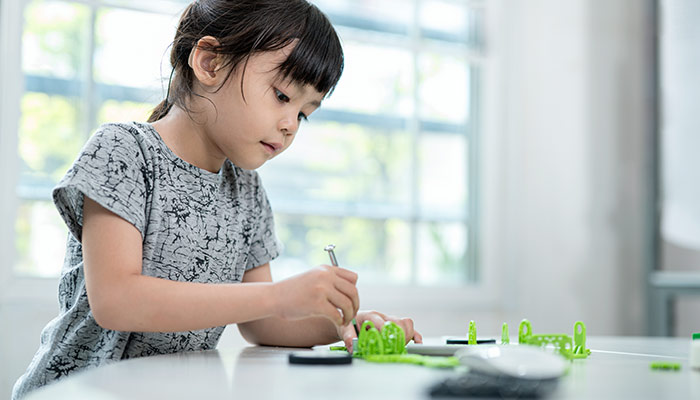While we believe that the books and resources recommended may be of value to you, keep in mind that these are suggestions only and you must do your own due diligence to determine whether the materials are appropriate and suitable for your use. PNC has no sponsorship or endorsement agreement with the authors or publishers of the materials listed.
TINKERING & MAKING

What's Inside
Children will explore the parts of a wind-up toy.

Lesson Objective
Children will take apart a wind-up toy to explore the movable parts inside.
Science
What You'll Need
Attention: Do not use items such as computers, cell phones, and televisions.
- A collection of toys with moving parts, such as wind-up toys, toys that light up or play music, or pull-along toys
- A wind-up toy (to take apart)
- Screwdrivers – Phillips and straight; different sizes
- Pliers – several pairs
- Safety goggles – 1 pair per child
- Magnifying glasses – 1 per child
- Practice boards (see Lesson Tips) – for children to practice working with tools
What To Do
- Display the toys, and ask the children to explain how they think each toy works.
- Demonstrate the wind-up toy for the children.
- Ask the children what parts they think might be inside the toy.
- Tell the children they are going to take the toy apart to see what is inside.
- Demonstrate how to use a screwdriver and pliers.
- Help children put on the safety goggles, and distribute screwdrivers and pliers.
- Allow the children some time to practice using the tools on the practice boards.
- Assist the children with removing any screws or fasteners that are holding the wind-up toy together.
- Lift the cover off and look inside.
- Ask questions about the parts (see Guiding Student Inquiry) as the children are examining the parts that are inside.
- Make sure all of the children get to see the inside, and then allow them to remove gears, springs, or wheels for further inspection.
- Assist the children with reassembling the toy. Once the toy is reassembled, try to wind it up to see if it works.
- Ask the children why they think the toy does not work and what they could do with it.
Resources
Home School Resources
Home educators: use these printable lesson PDFs to teach this lesson to your home schoolers. They're available in English and Spanish.
Content Provided By
Common Core State Standards Initiative – These lessons are aligned with the Common Core State Standards ("CCSS"). The CCSS provide a consistent, clear understanding of the concepts and skills children are expected to learn and guide teachers to provide their students with opportunities to gain these important skills and foundational knowledge [1]. Visit the CCSS


